La Trobe University EDU5SLL: A Literature Review on Second Language
VerifiedAdded on 2023/06/07
|12
|3133
|112
Literature Review
AI Summary
This literature review examines the development of English literacy skills among young adults and adults in the United States who speak a language other than English at home. It highlights the increasing number of such individuals and their need for support in developing spoken and written English proficiency. The review discusses the challenges faced by English language learners, including poverty, limited education, and the complexities of acquiring academic English. It also addresses the various factors influencing second language and literacy development, such as first language knowledge, education level, age, and social background. The review emphasizes the need for tailored instructional practices to support English language learners in developing their language and literacy skills, and concludes by identifying areas for future research to enhance effective teaching approaches for this population. Desklib offers a wealth of study resources, including solved assignments and past papers, to aid students in their academic endeavors.
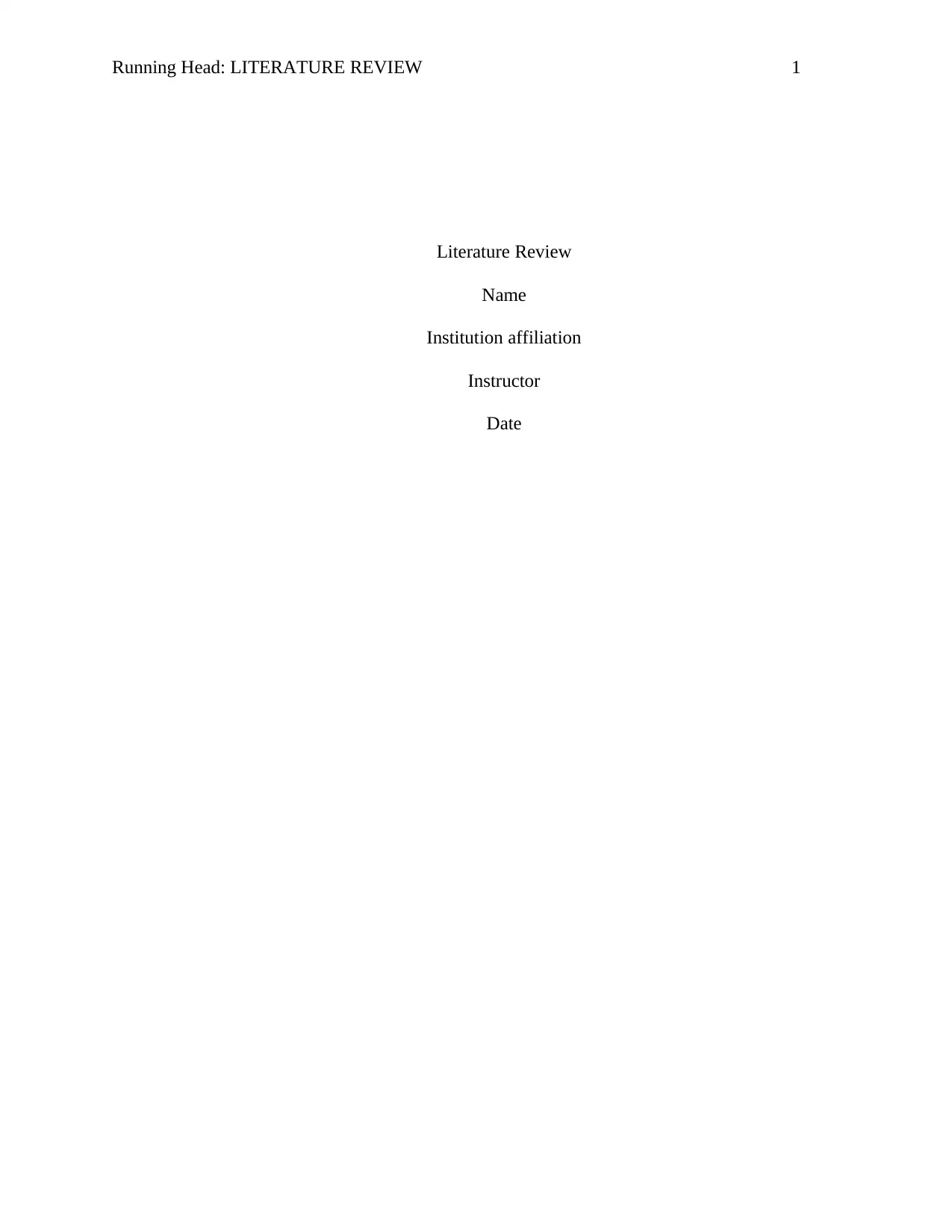
Running Head: LITERATURE REVIEW 1
Literature Review
Name
Institution affiliation
Instructor
Date
Literature Review
Name
Institution affiliation
Instructor
Date
Paraphrase This Document
Need a fresh take? Get an instant paraphrase of this document with our AI Paraphraser
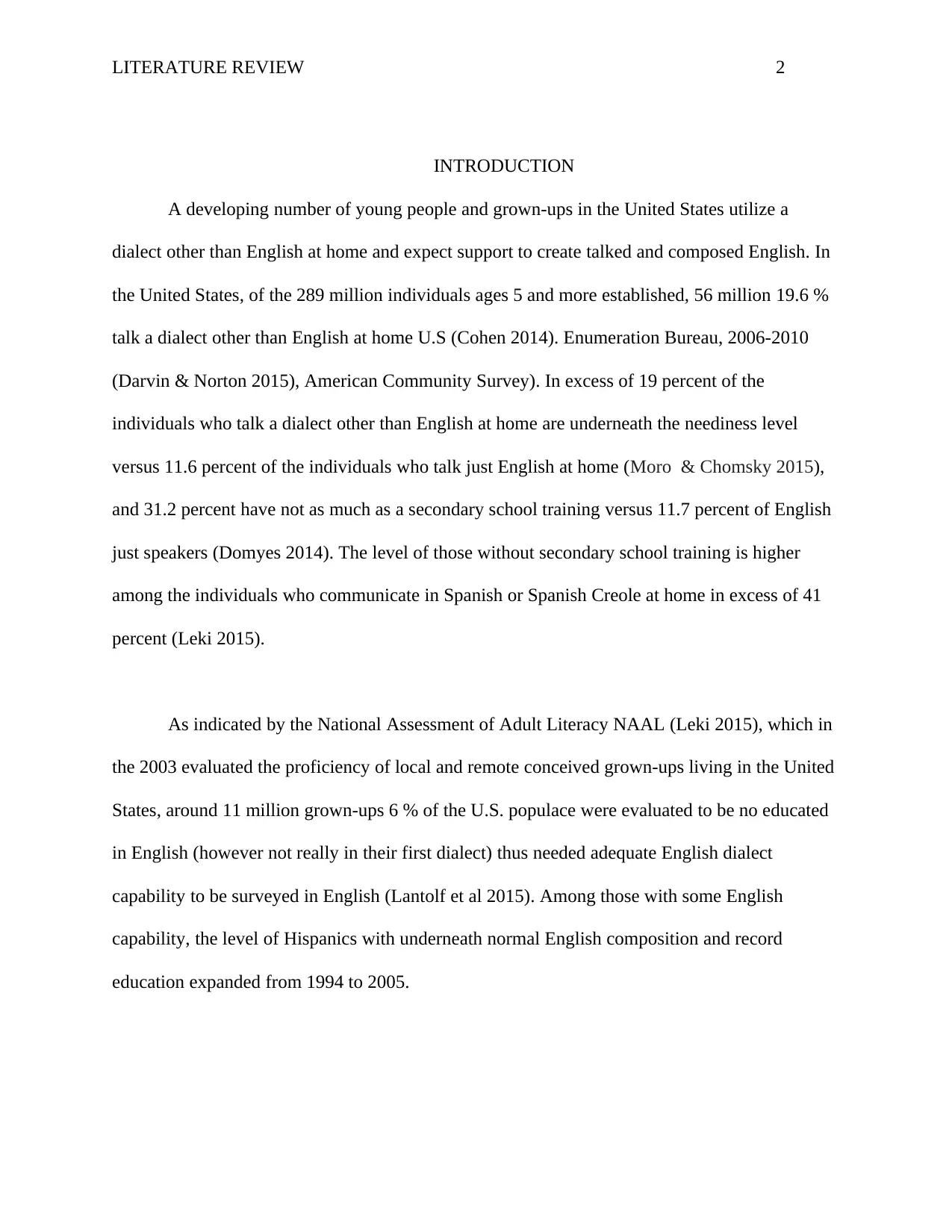
LITERATURE REVIEW 2
INTRODUCTION
A developing number of young people and grown-ups in the United States utilize a
dialect other than English at home and expect support to create talked and composed English. In
the United States, of the 289 million individuals ages 5 and more established, 56 million 19.6 %
talk a dialect other than English at home U.S (Cohen 2014). Enumeration Bureau, 2006-2010
(Darvin & Norton 2015), American Community Survey). In excess of 19 percent of the
individuals who talk a dialect other than English at home are underneath the neediness level
versus 11.6 percent of the individuals who talk just English at home (Moro & Chomsky 2015),
and 31.2 percent have not as much as a secondary school training versus 11.7 percent of English
just speakers (Domyes 2014). The level of those without secondary school training is higher
among the individuals who communicate in Spanish or Spanish Creole at home in excess of 41
percent (Leki 2015).
As indicated by the National Assessment of Adult Literacy NAAL (Leki 2015), which in
the 2003 evaluated the proficiency of local and remote conceived grown-ups living in the United
States, around 11 million grown-ups 6 % of the U.S. populace were evaluated to be no educated
in English (however not really in their first dialect) thus needed adequate English dialect
capability to be surveyed in English (Lantolf et al 2015). Among those with some English
capability, the level of Hispanics with underneath normal English composition and record
education expanded from 1994 to 2005.
INTRODUCTION
A developing number of young people and grown-ups in the United States utilize a
dialect other than English at home and expect support to create talked and composed English. In
the United States, of the 289 million individuals ages 5 and more established, 56 million 19.6 %
talk a dialect other than English at home U.S (Cohen 2014). Enumeration Bureau, 2006-2010
(Darvin & Norton 2015), American Community Survey). In excess of 19 percent of the
individuals who talk a dialect other than English at home are underneath the neediness level
versus 11.6 percent of the individuals who talk just English at home (Moro & Chomsky 2015),
and 31.2 percent have not as much as a secondary school training versus 11.7 percent of English
just speakers (Domyes 2014). The level of those without secondary school training is higher
among the individuals who communicate in Spanish or Spanish Creole at home in excess of 41
percent (Leki 2015).
As indicated by the National Assessment of Adult Literacy NAAL (Leki 2015), which in
the 2003 evaluated the proficiency of local and remote conceived grown-ups living in the United
States, around 11 million grown-ups 6 % of the U.S. populace were evaluated to be no educated
in English (however not really in their first dialect) thus needed adequate English dialect
capability to be surveyed in English (Lantolf et al 2015). Among those with some English
capability, the level of Hispanics with underneath normal English composition and record
education expanded from 1994 to 2005.
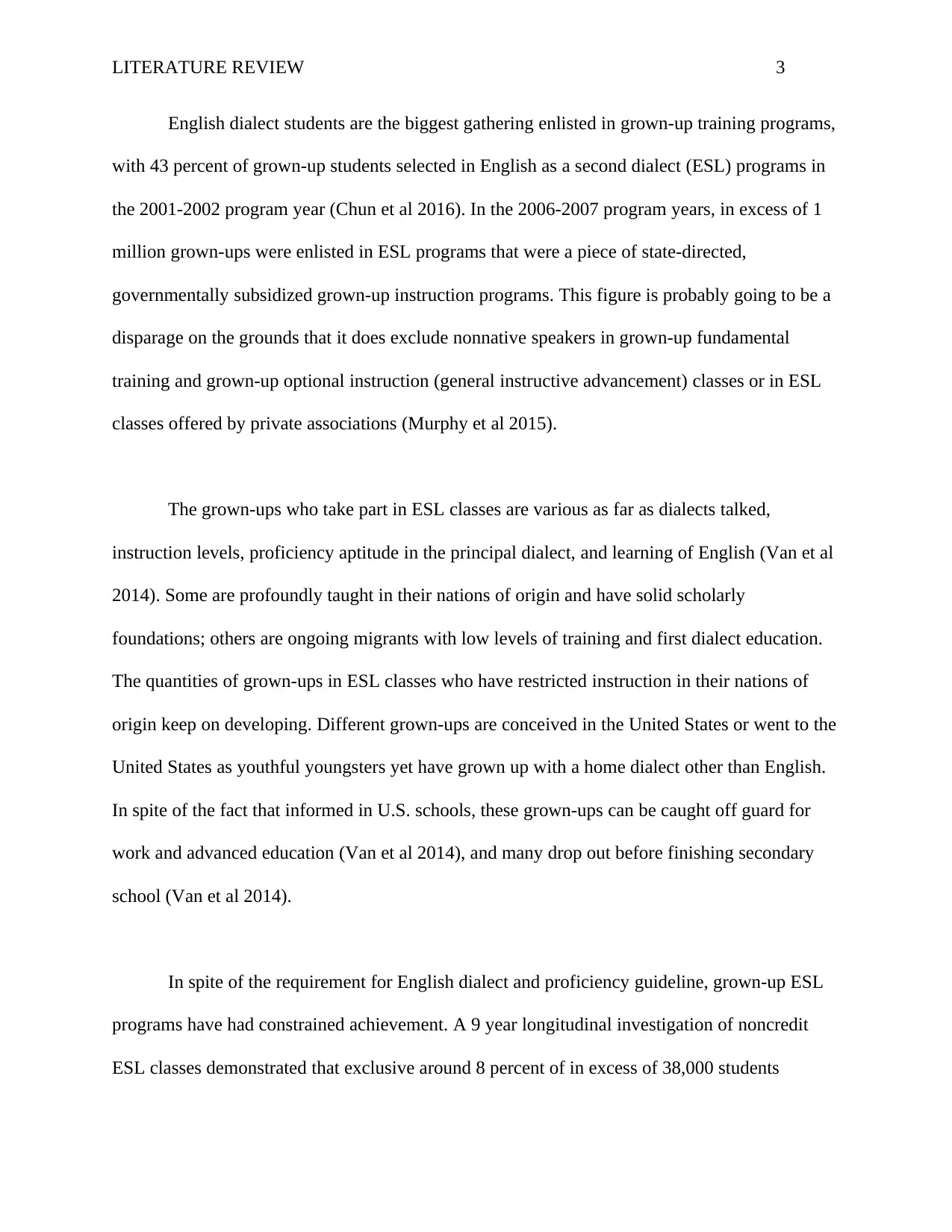
LITERATURE REVIEW 3
English dialect students are the biggest gathering enlisted in grown-up training programs,
with 43 percent of grown-up students selected in English as a second dialect (ESL) programs in
the 2001-2002 program year (Chun et al 2016). In the 2006-2007 program years, in excess of 1
million grown-ups were enlisted in ESL programs that were a piece of state-directed,
governmentally subsidized grown-up instruction programs. This figure is probably going to be a
disparage on the grounds that it does exclude nonnative speakers in grown-up fundamental
training and grown-up optional instruction (general instructive advancement) classes or in ESL
classes offered by private associations (Murphy et al 2015).
The grown-ups who take part in ESL classes are various as far as dialects talked,
instruction levels, proficiency aptitude in the principal dialect, and learning of English (Van et al
2014). Some are profoundly taught in their nations of origin and have solid scholarly
foundations; others are ongoing migrants with low levels of training and first dialect education.
The quantities of grown-ups in ESL classes who have restricted instruction in their nations of
origin keep on developing. Different grown-ups are conceived in the United States or went to the
United States as youthful youngsters yet have grown up with a home dialect other than English.
In spite of the fact that informed in U.S. schools, these grown-ups can be caught off guard for
work and advanced education (Van et al 2014), and many drop out before finishing secondary
school (Van et al 2014).
In spite of the requirement for English dialect and proficiency guideline, grown-up ESL
programs have had constrained achievement. A 9 year longitudinal investigation of noncredit
ESL classes demonstrated that exclusive around 8 percent of in excess of 38,000 students
English dialect students are the biggest gathering enlisted in grown-up training programs,
with 43 percent of grown-up students selected in English as a second dialect (ESL) programs in
the 2001-2002 program year (Chun et al 2016). In the 2006-2007 program years, in excess of 1
million grown-ups were enlisted in ESL programs that were a piece of state-directed,
governmentally subsidized grown-up instruction programs. This figure is probably going to be a
disparage on the grounds that it does exclude nonnative speakers in grown-up fundamental
training and grown-up optional instruction (general instructive advancement) classes or in ESL
classes offered by private associations (Murphy et al 2015).
The grown-ups who take part in ESL classes are various as far as dialects talked,
instruction levels, proficiency aptitude in the principal dialect, and learning of English (Van et al
2014). Some are profoundly taught in their nations of origin and have solid scholarly
foundations; others are ongoing migrants with low levels of training and first dialect education.
The quantities of grown-ups in ESL classes who have restricted instruction in their nations of
origin keep on developing. Different grown-ups are conceived in the United States or went to the
United States as youthful youngsters yet have grown up with a home dialect other than English.
In spite of the fact that informed in U.S. schools, these grown-ups can be caught off guard for
work and advanced education (Van et al 2014), and many drop out before finishing secondary
school (Van et al 2014).
In spite of the requirement for English dialect and proficiency guideline, grown-up ESL
programs have had constrained achievement. A 9 year longitudinal investigation of noncredit
ESL classes demonstrated that exclusive around 8 percent of in excess of 38,000 students
⊘ This is a preview!⊘
Do you want full access?
Subscribe today to unlock all pages.

Trusted by 1+ million students worldwide
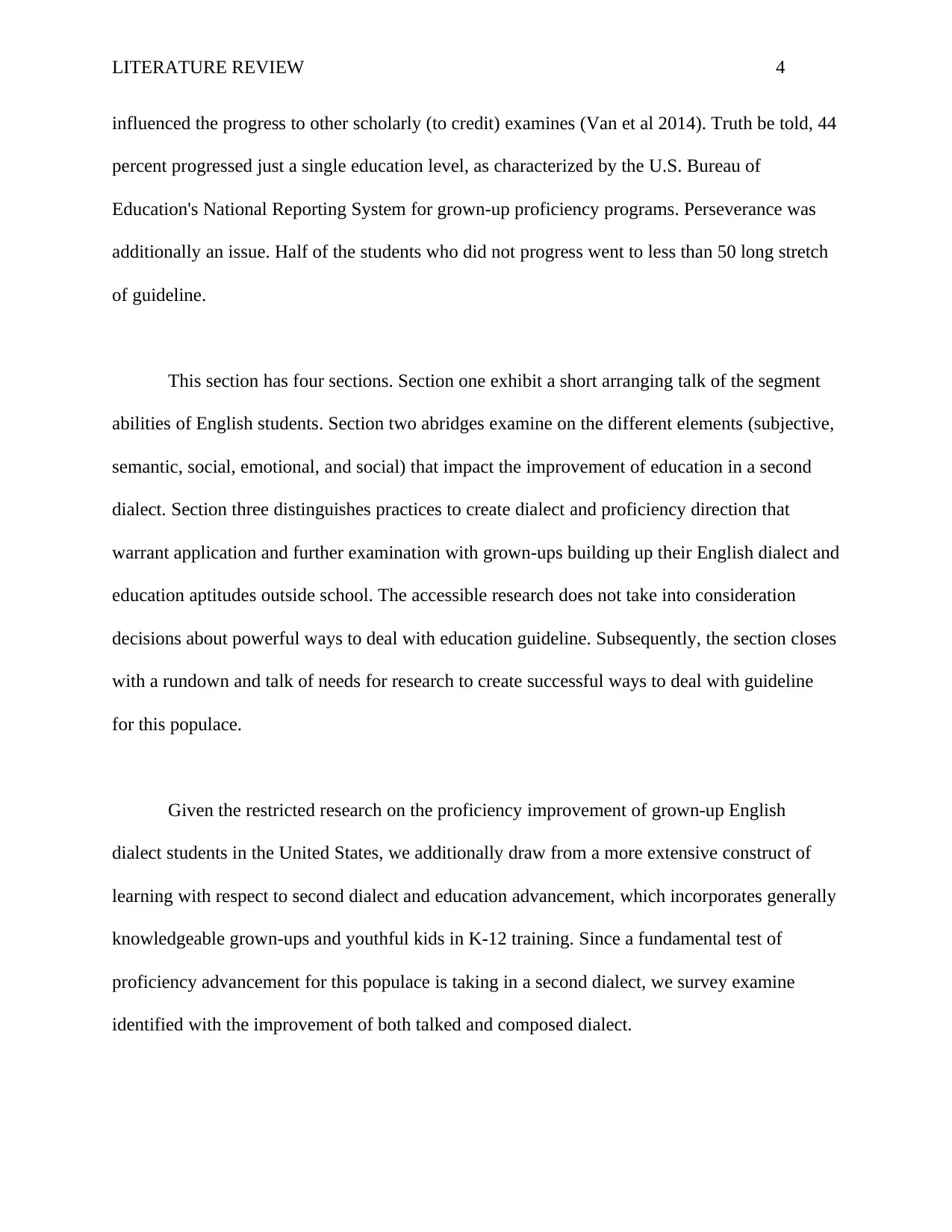
LITERATURE REVIEW 4
influenced the progress to other scholarly (to credit) examines (Van et al 2014). Truth be told, 44
percent progressed just a single education level, as characterized by the U.S. Bureau of
Education's National Reporting System for grown-up proficiency programs. Perseverance was
additionally an issue. Half of the students who did not progress went to less than 50 long stretch
of guideline.
This section has four sections. Section one exhibit a short arranging talk of the segment
abilities of English students. Section two abridges examine on the different elements (subjective,
semantic, social, emotional, and social) that impact the improvement of education in a second
dialect. Section three distinguishes practices to create dialect and proficiency direction that
warrant application and further examination with grown-ups building up their English dialect and
education aptitudes outside school. The accessible research does not take into consideration
decisions about powerful ways to deal with education guideline. Subsequently, the section closes
with a rundown and talk of needs for research to create successful ways to deal with guideline
for this populace.
Given the restricted research on the proficiency improvement of grown-up English
dialect students in the United States, we additionally draw from a more extensive construct of
learning with respect to second dialect and education advancement, which incorporates generally
knowledgeable grown-ups and youthful kids in K-12 training. Since a fundamental test of
proficiency advancement for this populace is taking in a second dialect, we survey examine
identified with the improvement of both talked and composed dialect.
influenced the progress to other scholarly (to credit) examines (Van et al 2014). Truth be told, 44
percent progressed just a single education level, as characterized by the U.S. Bureau of
Education's National Reporting System for grown-up proficiency programs. Perseverance was
additionally an issue. Half of the students who did not progress went to less than 50 long stretch
of guideline.
This section has four sections. Section one exhibit a short arranging talk of the segment
abilities of English students. Section two abridges examine on the different elements (subjective,
semantic, social, emotional, and social) that impact the improvement of education in a second
dialect. Section three distinguishes practices to create dialect and proficiency direction that
warrant application and further examination with grown-ups building up their English dialect and
education aptitudes outside school. The accessible research does not take into consideration
decisions about powerful ways to deal with education guideline. Subsequently, the section closes
with a rundown and talk of needs for research to create successful ways to deal with guideline
for this populace.
Given the restricted research on the proficiency improvement of grown-up English
dialect students in the United States, we additionally draw from a more extensive construct of
learning with respect to second dialect and education advancement, which incorporates generally
knowledgeable grown-ups and youthful kids in K-12 training. Since a fundamental test of
proficiency advancement for this populace is taking in a second dialect, we survey examine
identified with the improvement of both talked and composed dialect.
Paraphrase This Document
Need a fresh take? Get an instant paraphrase of this document with our AI Paraphraser
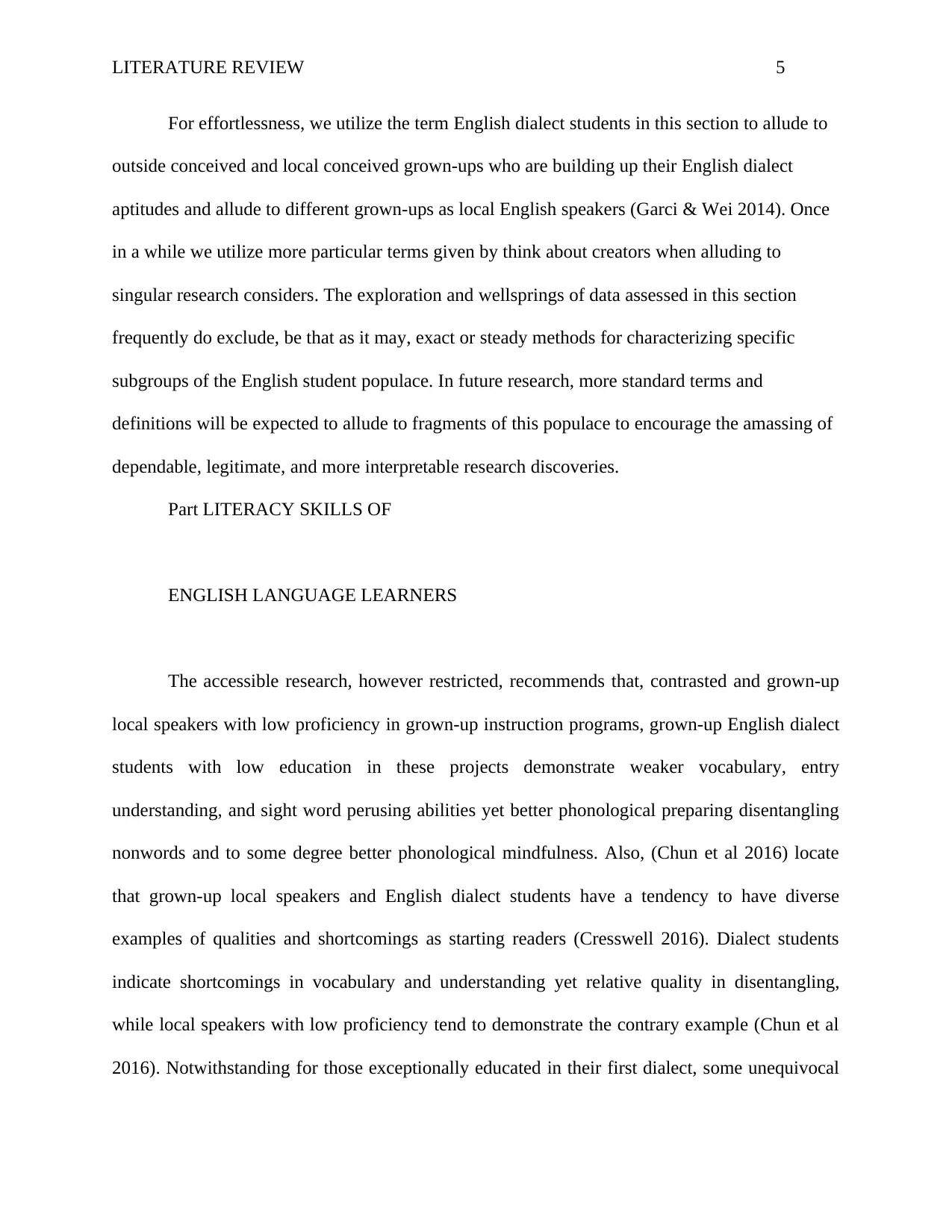
LITERATURE REVIEW 5
For effortlessness, we utilize the term English dialect students in this section to allude to
outside conceived and local conceived grown-ups who are building up their English dialect
aptitudes and allude to different grown-ups as local English speakers (Garci & Wei 2014). Once
in a while we utilize more particular terms given by think about creators when alluding to
singular research considers. The exploration and wellsprings of data assessed in this section
frequently do exclude, be that as it may, exact or steady methods for characterizing specific
subgroups of the English student populace. In future research, more standard terms and
definitions will be expected to allude to fragments of this populace to encourage the amassing of
dependable, legitimate, and more interpretable research discoveries.
Part LITERACY SKILLS OF
ENGLISH LANGUAGE LEARNERS
The accessible research, however restricted, recommends that, contrasted and grown-up
local speakers with low proficiency in grown-up instruction programs, grown-up English dialect
students with low education in these projects demonstrate weaker vocabulary, entry
understanding, and sight word perusing abilities yet better phonological preparing disentangling
nonwords and to some degree better phonological mindfulness. Also, (Chun et al 2016) locate
that grown-up local speakers and English dialect students have a tendency to have diverse
examples of qualities and shortcomings as starting readers (Cresswell 2016). Dialect students
indicate shortcomings in vocabulary and understanding yet relative quality in disentangling,
while local speakers with low proficiency tend to demonstrate the contrary example (Chun et al
2016). Notwithstanding for those exceptionally educated in their first dialect, some unequivocal
For effortlessness, we utilize the term English dialect students in this section to allude to
outside conceived and local conceived grown-ups who are building up their English dialect
aptitudes and allude to different grown-ups as local English speakers (Garci & Wei 2014). Once
in a while we utilize more particular terms given by think about creators when alluding to
singular research considers. The exploration and wellsprings of data assessed in this section
frequently do exclude, be that as it may, exact or steady methods for characterizing specific
subgroups of the English student populace. In future research, more standard terms and
definitions will be expected to allude to fragments of this populace to encourage the amassing of
dependable, legitimate, and more interpretable research discoveries.
Part LITERACY SKILLS OF
ENGLISH LANGUAGE LEARNERS
The accessible research, however restricted, recommends that, contrasted and grown-up
local speakers with low proficiency in grown-up instruction programs, grown-up English dialect
students with low education in these projects demonstrate weaker vocabulary, entry
understanding, and sight word perusing abilities yet better phonological preparing disentangling
nonwords and to some degree better phonological mindfulness. Also, (Chun et al 2016) locate
that grown-up local speakers and English dialect students have a tendency to have diverse
examples of qualities and shortcomings as starting readers (Cresswell 2016). Dialect students
indicate shortcomings in vocabulary and understanding yet relative quality in disentangling,
while local speakers with low proficiency tend to demonstrate the contrary example (Chun et al
2016). Notwithstanding for those exceptionally educated in their first dialect, some unequivocal
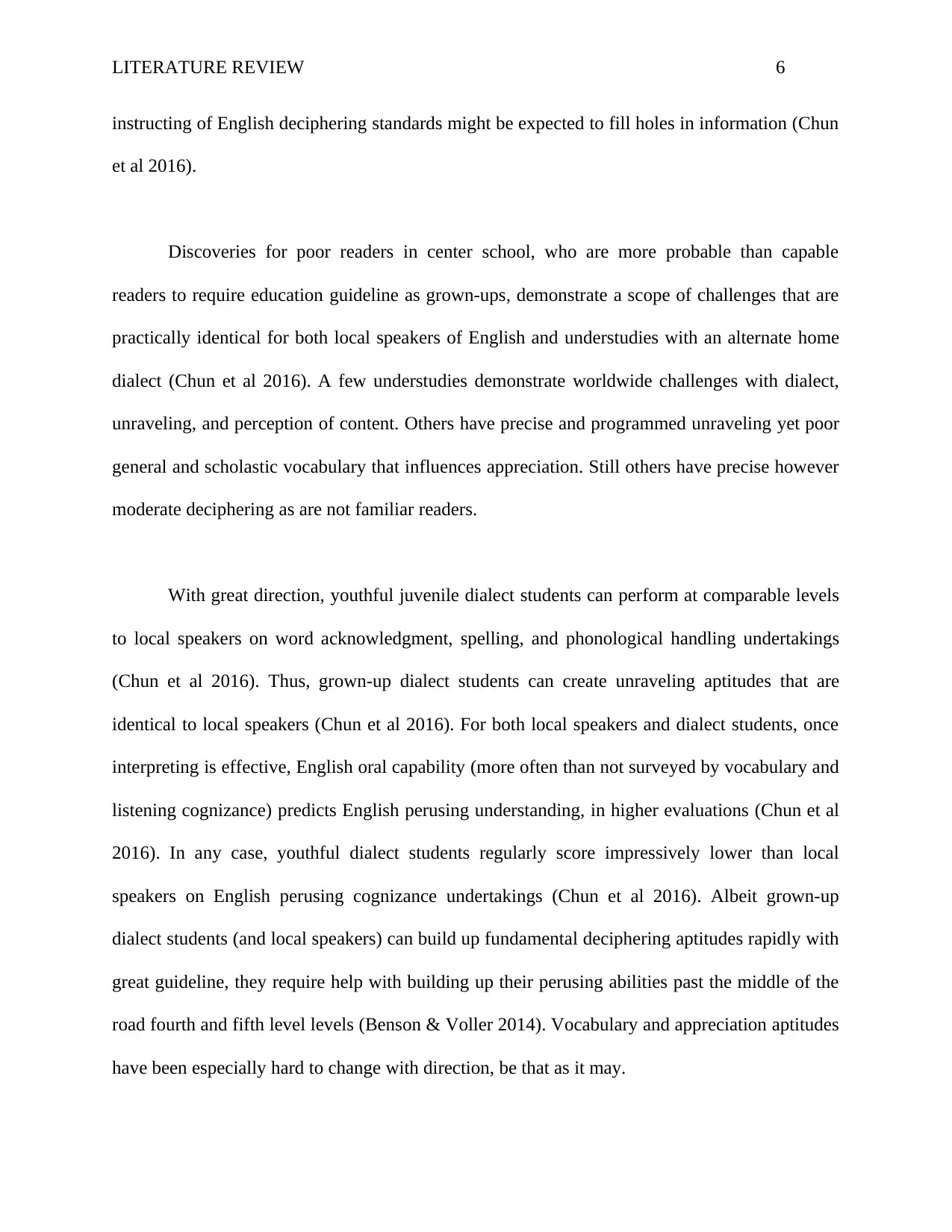
LITERATURE REVIEW 6
instructing of English deciphering standards might be expected to fill holes in information (Chun
et al 2016).
Discoveries for poor readers in center school, who are more probable than capable
readers to require education guideline as grown-ups, demonstrate a scope of challenges that are
practically identical for both local speakers of English and understudies with an alternate home
dialect (Chun et al 2016). A few understudies demonstrate worldwide challenges with dialect,
unraveling, and perception of content. Others have precise and programmed unraveling yet poor
general and scholastic vocabulary that influences appreciation. Still others have precise however
moderate deciphering as are not familiar readers.
With great direction, youthful juvenile dialect students can perform at comparable levels
to local speakers on word acknowledgment, spelling, and phonological handling undertakings
(Chun et al 2016). Thus, grown-up dialect students can create unraveling aptitudes that are
identical to local speakers (Chun et al 2016). For both local speakers and dialect students, once
interpreting is effective, English oral capability (more often than not surveyed by vocabulary and
listening cognizance) predicts English perusing understanding, in higher evaluations (Chun et al
2016). In any case, youthful dialect students regularly score impressively lower than local
speakers on English perusing cognizance undertakings (Chun et al 2016). Albeit grown-up
dialect students (and local speakers) can build up fundamental deciphering aptitudes rapidly with
great guideline, they require help with building up their perusing abilities past the middle of the
road fourth and fifth level levels (Benson & Voller 2014). Vocabulary and appreciation aptitudes
have been especially hard to change with direction, be that as it may.
instructing of English deciphering standards might be expected to fill holes in information (Chun
et al 2016).
Discoveries for poor readers in center school, who are more probable than capable
readers to require education guideline as grown-ups, demonstrate a scope of challenges that are
practically identical for both local speakers of English and understudies with an alternate home
dialect (Chun et al 2016). A few understudies demonstrate worldwide challenges with dialect,
unraveling, and perception of content. Others have precise and programmed unraveling yet poor
general and scholastic vocabulary that influences appreciation. Still others have precise however
moderate deciphering as are not familiar readers.
With great direction, youthful juvenile dialect students can perform at comparable levels
to local speakers on word acknowledgment, spelling, and phonological handling undertakings
(Chun et al 2016). Thus, grown-up dialect students can create unraveling aptitudes that are
identical to local speakers (Chun et al 2016). For both local speakers and dialect students, once
interpreting is effective, English oral capability (more often than not surveyed by vocabulary and
listening cognizance) predicts English perusing understanding, in higher evaluations (Chun et al
2016). In any case, youthful dialect students regularly score impressively lower than local
speakers on English perusing cognizance undertakings (Chun et al 2016). Albeit grown-up
dialect students (and local speakers) can build up fundamental deciphering aptitudes rapidly with
great guideline, they require help with building up their perusing abilities past the middle of the
road fourth and fifth level levels (Benson & Voller 2014). Vocabulary and appreciation aptitudes
have been especially hard to change with direction, be that as it may.
⊘ This is a preview!⊘
Do you want full access?
Subscribe today to unlock all pages.

Trusted by 1+ million students worldwide
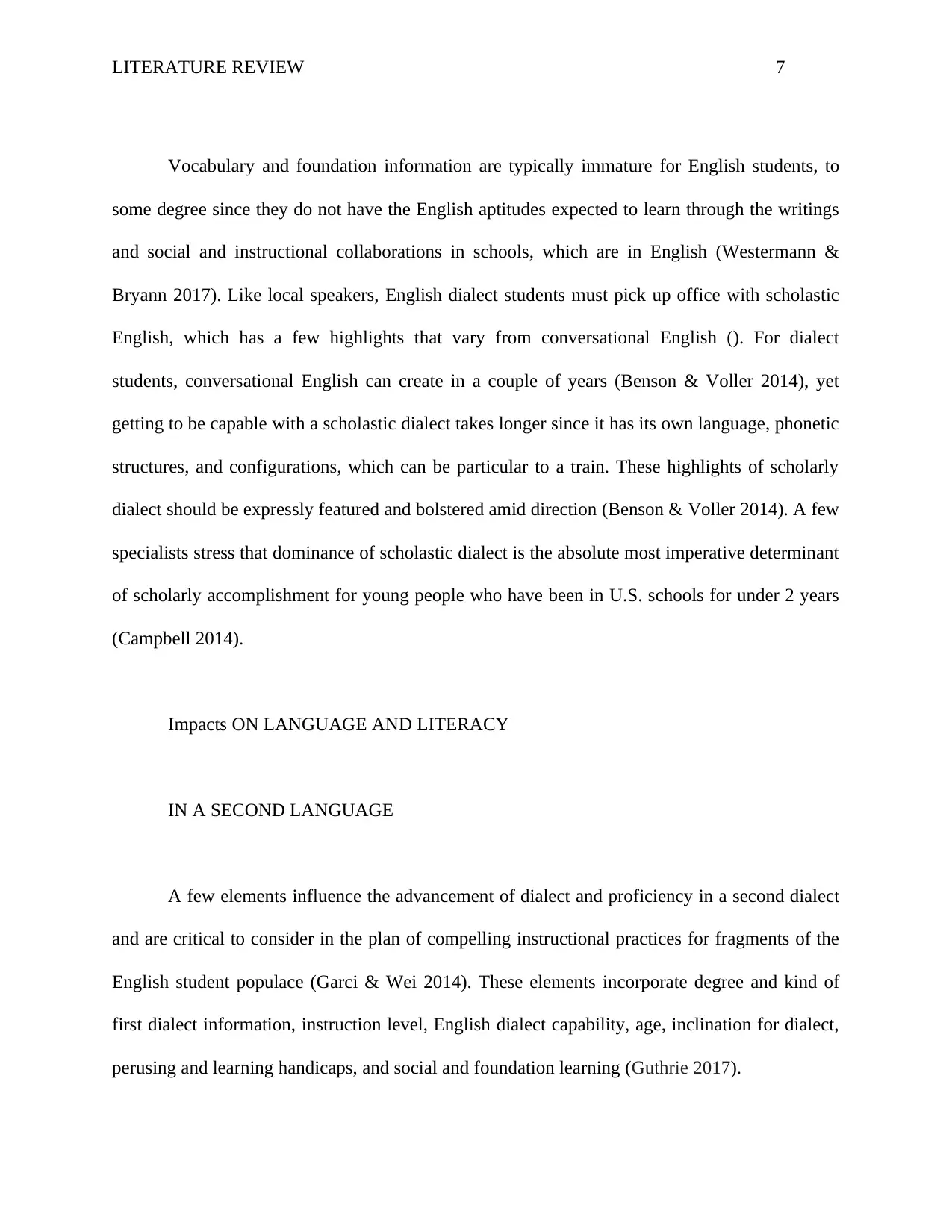
LITERATURE REVIEW 7
Vocabulary and foundation information are typically immature for English students, to
some degree since they do not have the English aptitudes expected to learn through the writings
and social and instructional collaborations in schools, which are in English (Westermann &
Bryann 2017). Like local speakers, English dialect students must pick up office with scholastic
English, which has a few highlights that vary from conversational English (). For dialect
students, conversational English can create in a couple of years (Benson & Voller 2014), yet
getting to be capable with a scholastic dialect takes longer since it has its own language, phonetic
structures, and configurations, which can be particular to a train. These highlights of scholarly
dialect should be expressly featured and bolstered amid direction (Benson & Voller 2014). A few
specialists stress that dominance of scholastic dialect is the absolute most imperative determinant
of scholarly accomplishment for young people who have been in U.S. schools for under 2 years
(Campbell 2014).
Impacts ON LANGUAGE AND LITERACY
IN A SECOND LANGUAGE
A few elements influence the advancement of dialect and proficiency in a second dialect
and are critical to consider in the plan of compelling instructional practices for fragments of the
English student populace (Garci & Wei 2014). These elements incorporate degree and kind of
first dialect information, instruction level, English dialect capability, age, inclination for dialect,
perusing and learning handicaps, and social and foundation learning (Guthrie 2017).
Vocabulary and foundation information are typically immature for English students, to
some degree since they do not have the English aptitudes expected to learn through the writings
and social and instructional collaborations in schools, which are in English (Westermann &
Bryann 2017). Like local speakers, English dialect students must pick up office with scholastic
English, which has a few highlights that vary from conversational English (). For dialect
students, conversational English can create in a couple of years (Benson & Voller 2014), yet
getting to be capable with a scholastic dialect takes longer since it has its own language, phonetic
structures, and configurations, which can be particular to a train. These highlights of scholarly
dialect should be expressly featured and bolstered amid direction (Benson & Voller 2014). A few
specialists stress that dominance of scholastic dialect is the absolute most imperative determinant
of scholarly accomplishment for young people who have been in U.S. schools for under 2 years
(Campbell 2014).
Impacts ON LANGUAGE AND LITERACY
IN A SECOND LANGUAGE
A few elements influence the advancement of dialect and proficiency in a second dialect
and are critical to consider in the plan of compelling instructional practices for fragments of the
English student populace (Garci & Wei 2014). These elements incorporate degree and kind of
first dialect information, instruction level, English dialect capability, age, inclination for dialect,
perusing and learning handicaps, and social and foundation learning (Guthrie 2017).
Paraphrase This Document
Need a fresh take? Get an instant paraphrase of this document with our AI Paraphraser
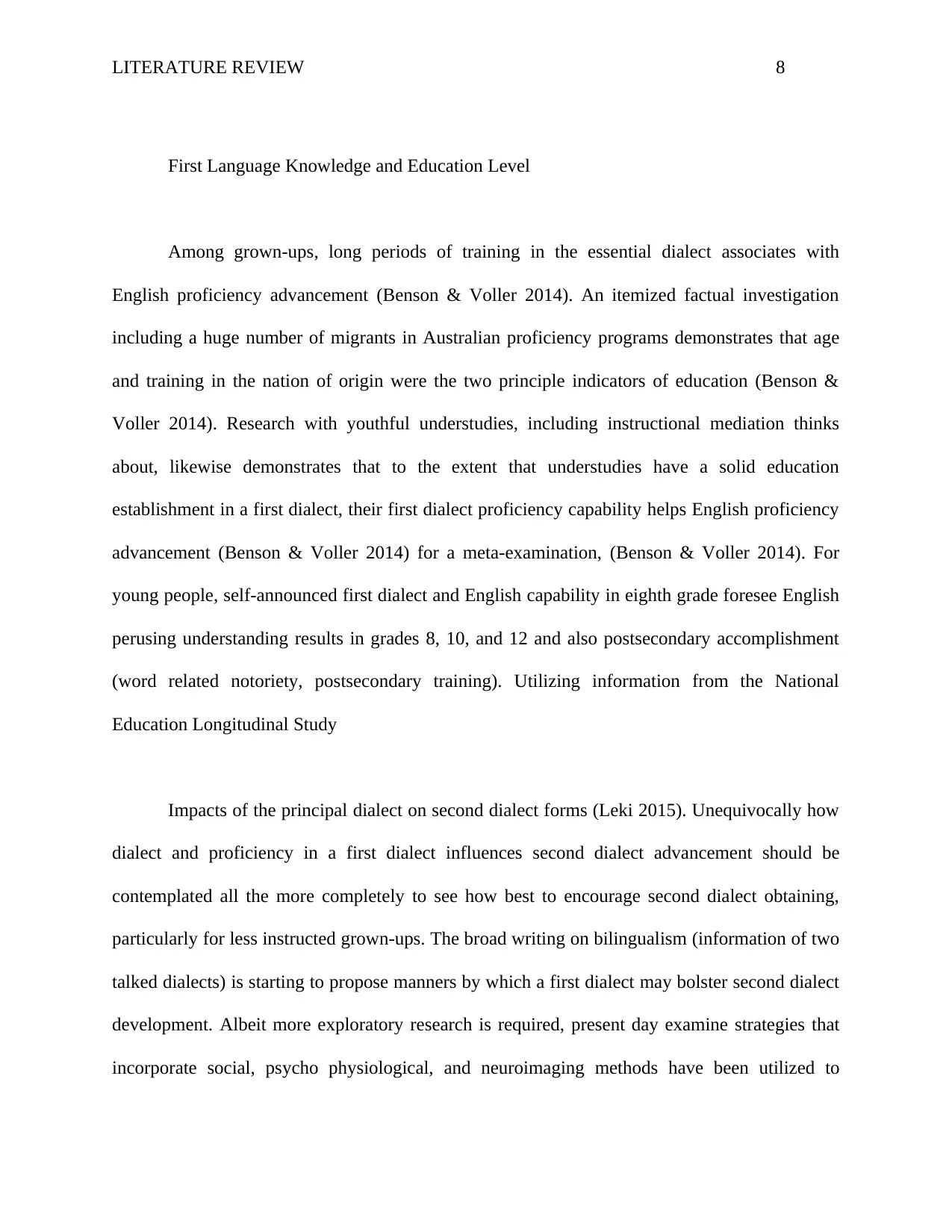
LITERATURE REVIEW 8
First Language Knowledge and Education Level
Among grown-ups, long periods of training in the essential dialect associates with
English proficiency advancement (Benson & Voller 2014). An itemized factual investigation
including a huge number of migrants in Australian proficiency programs demonstrates that age
and training in the nation of origin were the two principle indicators of education (Benson &
Voller 2014). Research with youthful understudies, including instructional mediation thinks
about, likewise demonstrates that to the extent that understudies have a solid education
establishment in a first dialect, their first dialect proficiency capability helps English proficiency
advancement (Benson & Voller 2014) for a meta-examination, (Benson & Voller 2014). For
young people, self-announced first dialect and English capability in eighth grade foresee English
perusing understanding results in grades 8, 10, and 12 and also postsecondary accomplishment
(word related notoriety, postsecondary training). Utilizing information from the National
Education Longitudinal Study
Impacts of the principal dialect on second dialect forms (Leki 2015). Unequivocally how
dialect and proficiency in a first dialect influences second dialect advancement should be
contemplated all the more completely to see how best to encourage second dialect obtaining,
particularly for less instructed grown-ups. The broad writing on bilingualism (information of two
talked dialects) is starting to propose manners by which a first dialect may bolster second dialect
development. Albeit more exploratory research is required, present day examine strategies that
incorporate social, psycho physiological, and neuroimaging methods have been utilized to
First Language Knowledge and Education Level
Among grown-ups, long periods of training in the essential dialect associates with
English proficiency advancement (Benson & Voller 2014). An itemized factual investigation
including a huge number of migrants in Australian proficiency programs demonstrates that age
and training in the nation of origin were the two principle indicators of education (Benson &
Voller 2014). Research with youthful understudies, including instructional mediation thinks
about, likewise demonstrates that to the extent that understudies have a solid education
establishment in a first dialect, their first dialect proficiency capability helps English proficiency
advancement (Benson & Voller 2014) for a meta-examination, (Benson & Voller 2014). For
young people, self-announced first dialect and English capability in eighth grade foresee English
perusing understanding results in grades 8, 10, and 12 and also postsecondary accomplishment
(word related notoriety, postsecondary training). Utilizing information from the National
Education Longitudinal Study
Impacts of the principal dialect on second dialect forms (Leki 2015). Unequivocally how
dialect and proficiency in a first dialect influences second dialect advancement should be
contemplated all the more completely to see how best to encourage second dialect obtaining,
particularly for less instructed grown-ups. The broad writing on bilingualism (information of two
talked dialects) is starting to propose manners by which a first dialect may bolster second dialect
development. Albeit more exploratory research is required, present day examine strategies that
incorporate social, psycho physiological, and neuroimaging methods have been utilized to
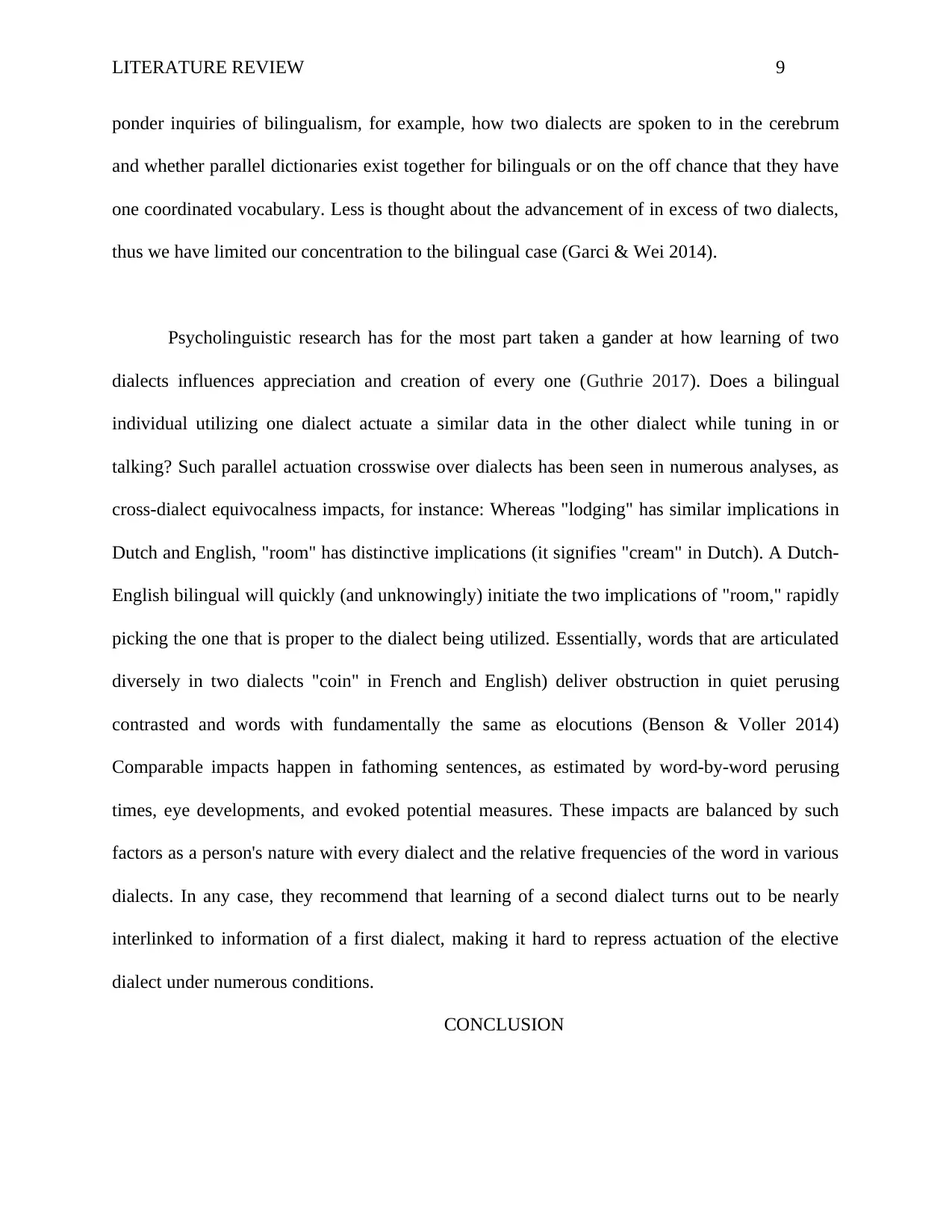
LITERATURE REVIEW 9
ponder inquiries of bilingualism, for example, how two dialects are spoken to in the cerebrum
and whether parallel dictionaries exist together for bilinguals or on the off chance that they have
one coordinated vocabulary. Less is thought about the advancement of in excess of two dialects,
thus we have limited our concentration to the bilingual case (Garci & Wei 2014).
Psycholinguistic research has for the most part taken a gander at how learning of two
dialects influences appreciation and creation of every one (Guthrie 2017). Does a bilingual
individual utilizing one dialect actuate a similar data in the other dialect while tuning in or
talking? Such parallel actuation crosswise over dialects has been seen in numerous analyses, as
cross-dialect equivocalness impacts, for instance: Whereas "lodging" has similar implications in
Dutch and English, "room" has distinctive implications (it signifies "cream" in Dutch). A Dutch-
English bilingual will quickly (and unknowingly) initiate the two implications of "room," rapidly
picking the one that is proper to the dialect being utilized. Essentially, words that are articulated
diversely in two dialects "coin" in French and English) deliver obstruction in quiet perusing
contrasted and words with fundamentally the same as elocutions (Benson & Voller 2014)
Comparable impacts happen in fathoming sentences, as estimated by word-by-word perusing
times, eye developments, and evoked potential measures. These impacts are balanced by such
factors as a person's nature with every dialect and the relative frequencies of the word in various
dialects. In any case, they recommend that learning of a second dialect turns out to be nearly
interlinked to information of a first dialect, making it hard to repress actuation of the elective
dialect under numerous conditions.
CONCLUSION
ponder inquiries of bilingualism, for example, how two dialects are spoken to in the cerebrum
and whether parallel dictionaries exist together for bilinguals or on the off chance that they have
one coordinated vocabulary. Less is thought about the advancement of in excess of two dialects,
thus we have limited our concentration to the bilingual case (Garci & Wei 2014).
Psycholinguistic research has for the most part taken a gander at how learning of two
dialects influences appreciation and creation of every one (Guthrie 2017). Does a bilingual
individual utilizing one dialect actuate a similar data in the other dialect while tuning in or
talking? Such parallel actuation crosswise over dialects has been seen in numerous analyses, as
cross-dialect equivocalness impacts, for instance: Whereas "lodging" has similar implications in
Dutch and English, "room" has distinctive implications (it signifies "cream" in Dutch). A Dutch-
English bilingual will quickly (and unknowingly) initiate the two implications of "room," rapidly
picking the one that is proper to the dialect being utilized. Essentially, words that are articulated
diversely in two dialects "coin" in French and English) deliver obstruction in quiet perusing
contrasted and words with fundamentally the same as elocutions (Benson & Voller 2014)
Comparable impacts happen in fathoming sentences, as estimated by word-by-word perusing
times, eye developments, and evoked potential measures. These impacts are balanced by such
factors as a person's nature with every dialect and the relative frequencies of the word in various
dialects. In any case, they recommend that learning of a second dialect turns out to be nearly
interlinked to information of a first dialect, making it hard to repress actuation of the elective
dialect under numerous conditions.
CONCLUSION
⊘ This is a preview!⊘
Do you want full access?
Subscribe today to unlock all pages.

Trusted by 1+ million students worldwide
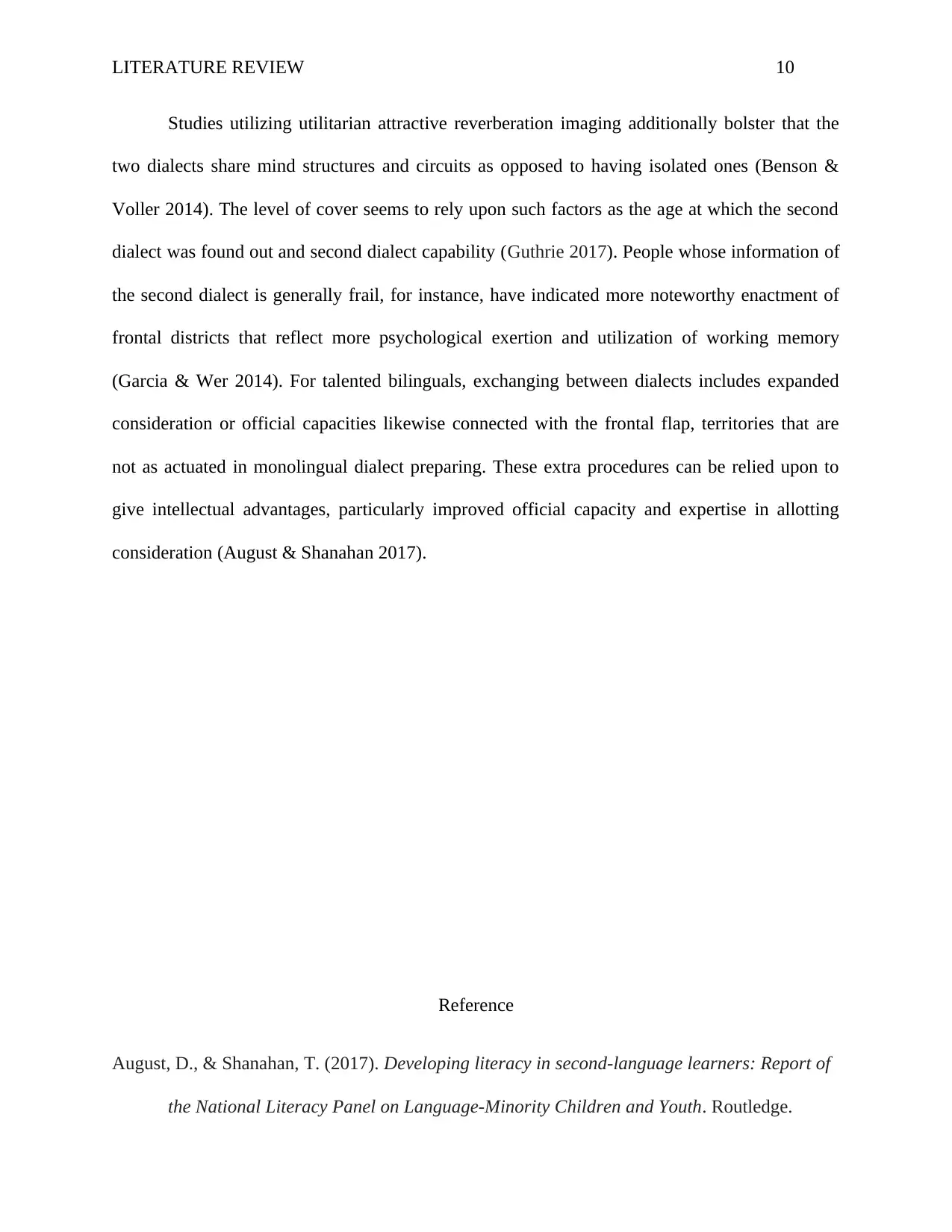
LITERATURE REVIEW 10
Studies utilizing utilitarian attractive reverberation imaging additionally bolster that the
two dialects share mind structures and circuits as opposed to having isolated ones (Benson &
Voller 2014). The level of cover seems to rely upon such factors as the age at which the second
dialect was found out and second dialect capability (Guthrie 2017). People whose information of
the second dialect is generally frail, for instance, have indicated more noteworthy enactment of
frontal districts that reflect more psychological exertion and utilization of working memory
(Garcia & Wer 2014). For talented bilinguals, exchanging between dialects includes expanded
consideration or official capacities likewise connected with the frontal flap, territories that are
not as actuated in monolingual dialect preparing. These extra procedures can be relied upon to
give intellectual advantages, particularly improved official capacity and expertise in allotting
consideration (August & Shanahan 2017).
Reference
August, D., & Shanahan, T. (2017). Developing literacy in second-language learners: Report of
the National Literacy Panel on Language-Minority Children and Youth. Routledge.
Studies utilizing utilitarian attractive reverberation imaging additionally bolster that the
two dialects share mind structures and circuits as opposed to having isolated ones (Benson &
Voller 2014). The level of cover seems to rely upon such factors as the age at which the second
dialect was found out and second dialect capability (Guthrie 2017). People whose information of
the second dialect is generally frail, for instance, have indicated more noteworthy enactment of
frontal districts that reflect more psychological exertion and utilization of working memory
(Garcia & Wer 2014). For talented bilinguals, exchanging between dialects includes expanded
consideration or official capacities likewise connected with the frontal flap, territories that are
not as actuated in monolingual dialect preparing. These extra procedures can be relied upon to
give intellectual advantages, particularly improved official capacity and expertise in allotting
consideration (August & Shanahan 2017).
Reference
August, D., & Shanahan, T. (2017). Developing literacy in second-language learners: Report of
the National Literacy Panel on Language-Minority Children and Youth. Routledge.
Paraphrase This Document
Need a fresh take? Get an instant paraphrase of this document with our AI Paraphraser
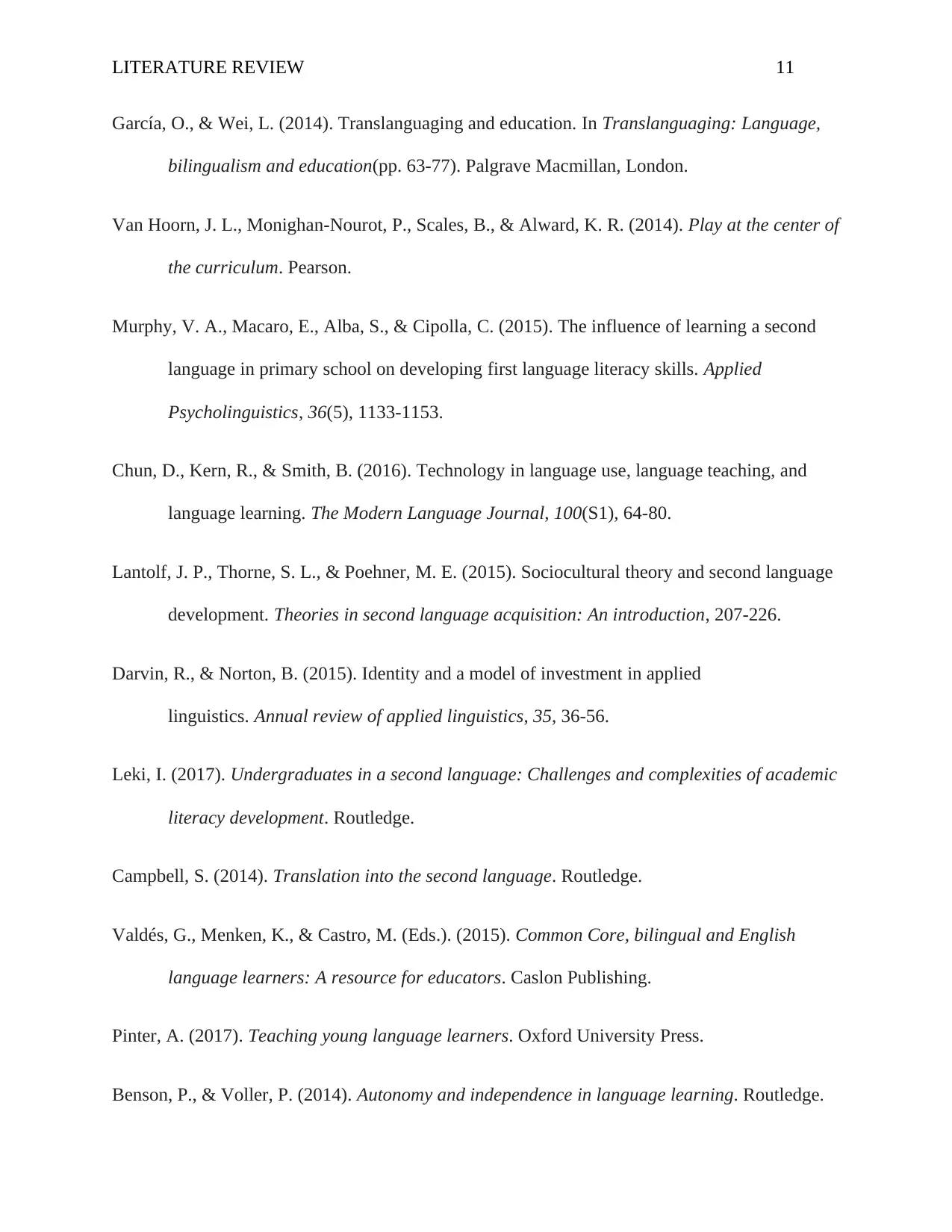
LITERATURE REVIEW 11
García, O., & Wei, L. (2014). Translanguaging and education. In Translanguaging: Language,
bilingualism and education(pp. 63-77). Palgrave Macmillan, London.
Van Hoorn, J. L., Monighan-Nourot, P., Scales, B., & Alward, K. R. (2014). Play at the center of
the curriculum. Pearson.
Murphy, V. A., Macaro, E., Alba, S., & Cipolla, C. (2015). The influence of learning a second
language in primary school on developing first language literacy skills. Applied
Psycholinguistics, 36(5), 1133-1153.
Chun, D., Kern, R., & Smith, B. (2016). Technology in language use, language teaching, and
language learning. The Modern Language Journal, 100(S1), 64-80.
Lantolf, J. P., Thorne, S. L., & Poehner, M. E. (2015). Sociocultural theory and second language
development. Theories in second language acquisition: An introduction, 207-226.
Darvin, R., & Norton, B. (2015). Identity and a model of investment in applied
linguistics. Annual review of applied linguistics, 35, 36-56.
Leki, I. (2017). Undergraduates in a second language: Challenges and complexities of academic
literacy development. Routledge.
Campbell, S. (2014). Translation into the second language. Routledge.
Valdés, G., Menken, K., & Castro, M. (Eds.). (2015). Common Core, bilingual and English
language learners: A resource for educators. Caslon Publishing.
Pinter, A. (2017). Teaching young language learners. Oxford University Press.
Benson, P., & Voller, P. (2014). Autonomy and independence in language learning. Routledge.
García, O., & Wei, L. (2014). Translanguaging and education. In Translanguaging: Language,
bilingualism and education(pp. 63-77). Palgrave Macmillan, London.
Van Hoorn, J. L., Monighan-Nourot, P., Scales, B., & Alward, K. R. (2014). Play at the center of
the curriculum. Pearson.
Murphy, V. A., Macaro, E., Alba, S., & Cipolla, C. (2015). The influence of learning a second
language in primary school on developing first language literacy skills. Applied
Psycholinguistics, 36(5), 1133-1153.
Chun, D., Kern, R., & Smith, B. (2016). Technology in language use, language teaching, and
language learning. The Modern Language Journal, 100(S1), 64-80.
Lantolf, J. P., Thorne, S. L., & Poehner, M. E. (2015). Sociocultural theory and second language
development. Theories in second language acquisition: An introduction, 207-226.
Darvin, R., & Norton, B. (2015). Identity and a model of investment in applied
linguistics. Annual review of applied linguistics, 35, 36-56.
Leki, I. (2017). Undergraduates in a second language: Challenges and complexities of academic
literacy development. Routledge.
Campbell, S. (2014). Translation into the second language. Routledge.
Valdés, G., Menken, K., & Castro, M. (Eds.). (2015). Common Core, bilingual and English
language learners: A resource for educators. Caslon Publishing.
Pinter, A. (2017). Teaching young language learners. Oxford University Press.
Benson, P., & Voller, P. (2014). Autonomy and independence in language learning. Routledge.
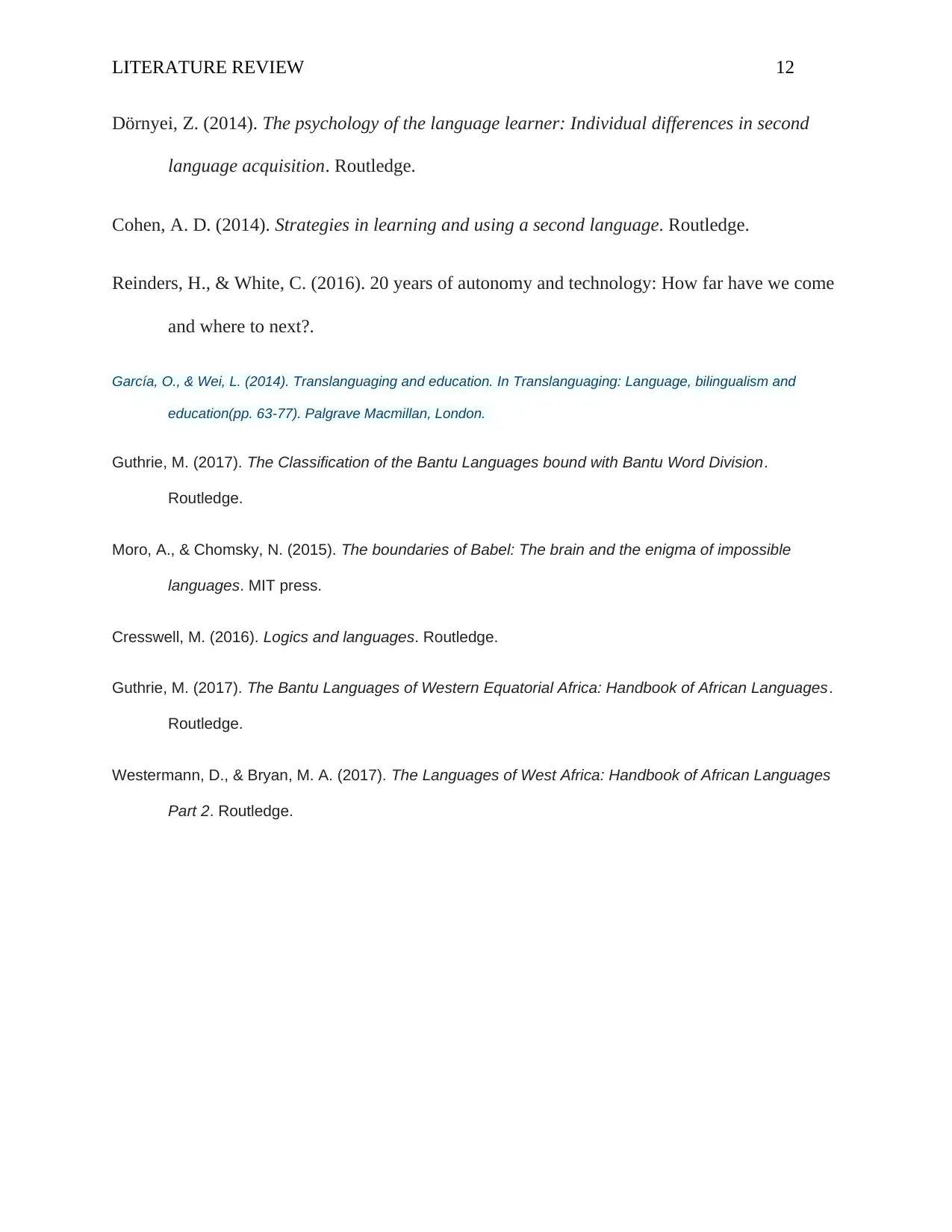
LITERATURE REVIEW 12
Dörnyei, Z. (2014). The psychology of the language learner: Individual differences in second
language acquisition. Routledge.
Cohen, A. D. (2014). Strategies in learning and using a second language. Routledge.
Reinders, H., & White, C. (2016). 20 years of autonomy and technology: How far have we come
and where to next?.
García, O., & Wei, L. (2014). Translanguaging and education. In Translanguaging: Language, bilingualism and
education(pp. 63-77). Palgrave Macmillan, London.
Guthrie, M. (2017). The Classification of the Bantu Languages bound with Bantu Word Division.
Routledge.
Moro, A., & Chomsky, N. (2015). The boundaries of Babel: The brain and the enigma of impossible
languages. MIT press.
Cresswell, M. (2016). Logics and languages. Routledge.
Guthrie, M. (2017). The Bantu Languages of Western Equatorial Africa: Handbook of African Languages.
Routledge.
Westermann, D., & Bryan, M. A. (2017). The Languages of West Africa: Handbook of African Languages
Part 2. Routledge.
Dörnyei, Z. (2014). The psychology of the language learner: Individual differences in second
language acquisition. Routledge.
Cohen, A. D. (2014). Strategies in learning and using a second language. Routledge.
Reinders, H., & White, C. (2016). 20 years of autonomy and technology: How far have we come
and where to next?.
García, O., & Wei, L. (2014). Translanguaging and education. In Translanguaging: Language, bilingualism and
education(pp. 63-77). Palgrave Macmillan, London.
Guthrie, M. (2017). The Classification of the Bantu Languages bound with Bantu Word Division.
Routledge.
Moro, A., & Chomsky, N. (2015). The boundaries of Babel: The brain and the enigma of impossible
languages. MIT press.
Cresswell, M. (2016). Logics and languages. Routledge.
Guthrie, M. (2017). The Bantu Languages of Western Equatorial Africa: Handbook of African Languages.
Routledge.
Westermann, D., & Bryan, M. A. (2017). The Languages of West Africa: Handbook of African Languages
Part 2. Routledge.
⊘ This is a preview!⊘
Do you want full access?
Subscribe today to unlock all pages.

Trusted by 1+ million students worldwide
1 out of 12
Your All-in-One AI-Powered Toolkit for Academic Success.
+13062052269
info@desklib.com
Available 24*7 on WhatsApp / Email
![[object Object]](/_next/static/media/star-bottom.7253800d.svg)
Unlock your academic potential
Copyright © 2020–2025 A2Z Services. All Rights Reserved. Developed and managed by ZUCOL.